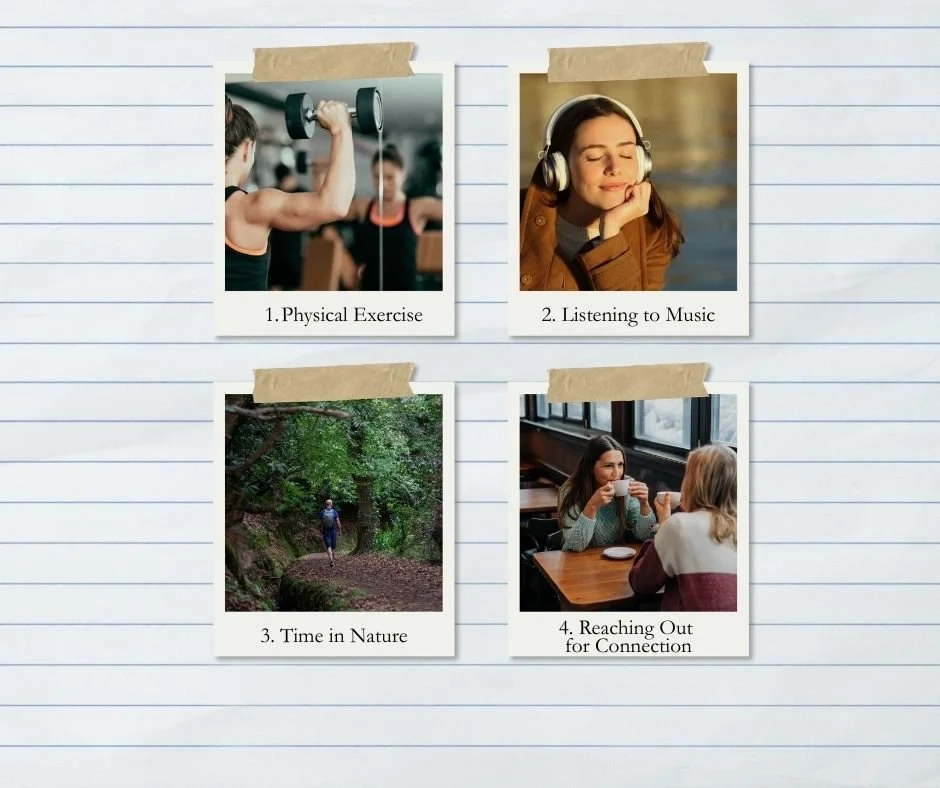What You Can Do When You’re Freaking Out: Simple, Science-Backed Ways to Soothe Your Nervous System
We all have moments when our emotions feel too big, too fast, or simply overwhelming. When you’re in that state—heart racing, mind spinning, body on high alert—it can be hard to remember what actually helps.
Emotion regulation isn’t about “getting rid” of feelings. It’s about supporting your body and mind so you can move through intensity with more steadiness and choice. The way we work with our emotions has a powerful impact on our overall well-being, our relationships, and how grounded we feel in daily life.
Below are practical, evidence-based tools you can lean on when you’re activated or anxious. They come from neuroscience, somatic therapy, psychology, and physiology—but most importantly, they’re things real humans can actually do in real moments of distress.
Somatic + Body-Based Techniques
These strategies work directly with your nervous system. When you’re overwhelmed, the body often needs to shift first before your mind can catch up. Many of these techniques tap into the vagus nerve—an important pathway for calming, grounding, and feeling safe.
1. Cold Exposure
Try:
Splashing cold water on your face
A brief cold shower
A cold pack on your chest or neck
This practice, known as the Cold Face Test (CFT), is a simple and effective way to stimulate the vagus nerve. The cold sensation triggers the diving reflex, which leads to bradycardia (a slowing of the heart rate) and activates the parasympathetic nervous system, promoting a state of calm and reducing the body's acute stress response
2. Humming or Gentle Vocalization
Try:
Humming
Singing low tones (like a long “voo”)
Sustained vowel sounds
The vagus nerve is connected to the vocal cords and the muscles at the back of the throat. The vibrations created by humming and other vocalizations stimulate the vagus nerve, which helps to slow the heart rate, activate the parasympathetic nervous system, and induce a state of relaxation.
3. Deep, Slow Breathing
Try:
Diaphragmatic (belly) breathing
Box breathing (inhale – hold – exhale – hold)
Longer exhales than inhales
Slow, deep, and intentional breathing is one of the most direct ways to down-regulate the nervous system. It stimulates the vagus nerve, sending signals to the brain to activate the parasympathetic nervous system. This process helps to moderate the fightor-flight response and reduce feelings of anxiety and panic
4. Progressive Muscle Relaxation
Try:
Tense a muscle group for ~5 seconds
Release
Move through your body from feet to head
This technique helps to release physical tension stored in the muscles. The act of consciously releasing muscular contraction sends feedback to the nervous system that it is safe to relax, thereby reducing physiological arousal.
5. Mindful Movement
Try:
Yoga
Qigong
Tai Chi
Gentle stretching with slow breath
These practices promote a sense of balance and calm in the nervous system. The combination of physical postures, breathwork, and mindfulness helps to regulate the ANS and improve the mind-body connection.
Cognitive + Attention-Based Techniques
These tools help anchor your mind when your thoughts start spiraling. They engage the parts of the brain responsible for reflection and perspective, which naturally helps turn down the intensity of big emotions.
1. The 5-4-3-2-1 Grounding Exercise
Name:
5 things you can see
4 things you can feel
3 things you can hear
2 things you can smell
1 thing you can taste
This exercise pulls your attention away from distressing internal thoughts or emotions and directs it to the external environment. By focusing on concrete sensory information, you signal to your nervous system that you are in the present moment and physically safe, which can interrupt cycles of anxiety or rumination.
2. Expressive Writing
Try:
Set a 5–10 minute timer
Write without stopping
Don’t edit or judge what comes out
The act of putting feelings into words, known as affect labeling, engages the prefrontal cortex. This activation helps to dampen the response of the amygdala, the brain's fear center. This process allows for the categorization and processing of emotions, strengthening emotional regulation and even rewiring neural pathways over time.
3. Gratitude Practice
Try:
Listing 3 things you’re grateful for
Writing them down
Saying them out loud
Cultivating gratitude shifts your focus toward positive emotions and experiences. This practice has been shown to stimulate the release of key neurotransmitters like dopamine and serotonin, which play a vital role in mood regulation and feelings of well-being.
4. Safe Place Visualization
Try:
Close your eyes
Imagine a place where you feel completely safe
Engage all your senses: what you see, hear, smell, feel, and even taste
This technique provides a mental escape from a stressful state. By creating a detailed internal sanctuary, you can signal safety to your nervous system and activate the parasympathetic response, just as you would in a physically safe environment.
Behavioral + Environmental Techniques
Sometimes what your system needs is action, movement, or connection.
1. Physical Exercise
Try:
A brisk walk
Dancing
A short workout
Any movement your body enjoys
Exercise has a powerful, multifaceted effect on the brain and body. It increases the production of endorphins, the body's natural mood elevators. It also boosts levels of crucial neurotransmitters like dopamine and serotonin, stimulates neuroplasticity through factors like BDNF (BrainDerived Neurotrophic Factor), and reduces levels of the stress hormone cortisol and systemic inflammation.
2. Listening to Music
Choose:
Songs you find soothing
Music that feels comforting
Anything that helps your body soften
Music directly taps into the brain's reward and pleasure circuits. It triggers the release of dopamine in the ventral striatum, similar to other highly rewarding stimuli. It also influences the autonomic nervous system, affecting heart rate and respiration, and can modulate the release of other key neurochemicals like opioids, noradrenaline, and serotonin, leading to profound shifts in emotional state.
3. Spending Time in Nature
Try:
A walk in a park
Sitting near trees or water
Bringing natural elements into your space
Exposure to nature has been shown to reduce stress and improve mood. It can lower levels of cortisol, improve attention, and activate the parasympathetic nervous system. Even brief periods in a natural setting can have a restorative effect on mental well-being.
4. Reaching Out for Connection
Try:
Talking to someone you trust
Sitting with a loved one or pet
Texting a supportive friend
Positive social engagement triggers the release of oxytocin, often called the "bonding hormone." Oxytocin plays a crucial role in stress regulation by inhibiting the activity of the hypothalamicpituitary-adrenal (HPA) axis, the body's central stress response system. This creates feelings of well-being and buffers against the physiological effects of stress.
Emotion regulation is not about suppressing or ignoring feelings, but rather about developing a toolkit of strategies to navigate them effectively. The techniques outlined in this document offer a range of accessible, evidence-based methods for influencing our emotional and physiological states. By understanding the scientific principles behind them —from vagus nerve stimulation and neurotransmitter release to the calming of the amygdala—we can empower ourselves to respond to life's challenges with greater resilience, balance, and intention. Consistent practice is key, as these techniques help to retrain the nervous system and build new, healthier neural pathways over time.


